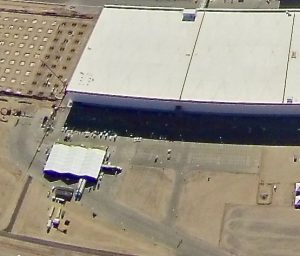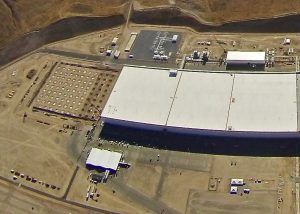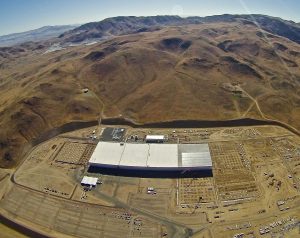News
[Photos] Preparations for Tesla’s Gigafactory event are well underway
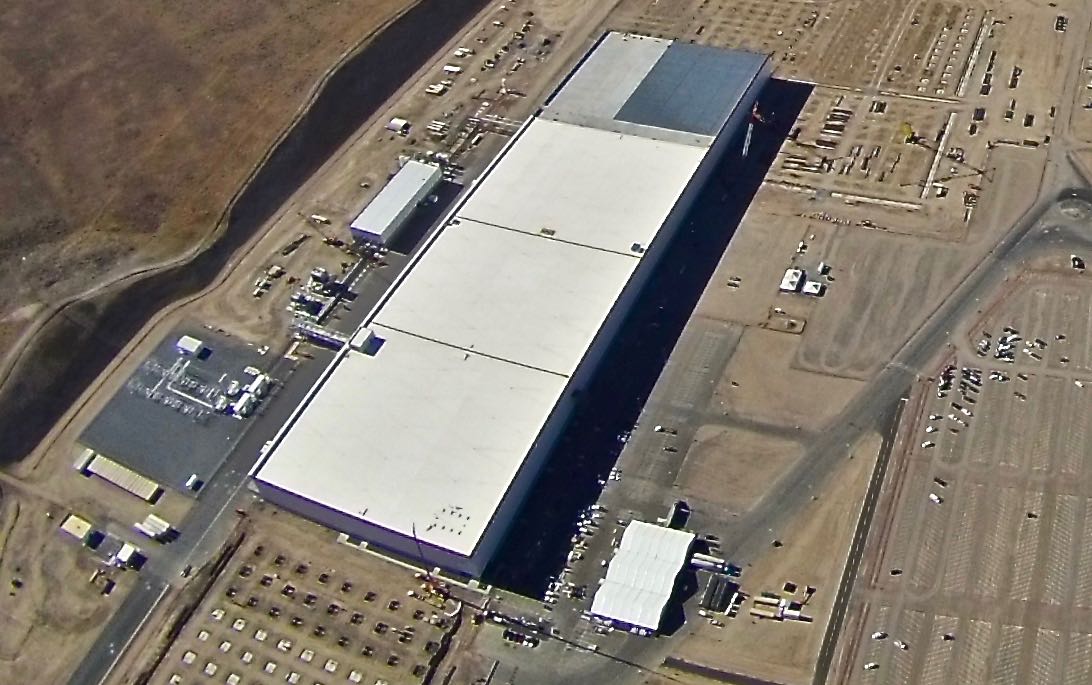
New aerial photos obtained by Teslarati show party preparations for Tesla’s upcoming July 29 Gigafactory event are well underway. Photos of Tesla’s $5 billion high-tech battery plant located 20 miles east of Reno, Nevada reveal that the electric automaker turned energy company has perched a large white tent off the main road, rightfully named Electric Avenue, that leads into the Gigafactory.
Several tractor trailers are seen surrounding the tent with a pair of trailers positioned in a way that would suggest cargo was being unloaded into the tent. Taking into account that commercial tractor trailers are generally 53 feet in length, we approximate the tent to be about 210 feet in length and 105 feet wide, or twice the size of a professional NBA basketball court.
- Tesla Gigafactory event prepartions seen in aerial photo
- A newly perched white tent is seen near the entrance to the Gigafactory
- Tesla Gigafactory, July 24, 2016
Also seen in the photos taken on Sunday, July 24 by local flight instructor Josh Mcdonald are roughly 2,000 newly painted parking spaces located directly west of Tesla’s Gigafactory 1. Tesla will be providing valet parking for those driving to Gigafactory 1 via Electric Avenue, but will also have shuttle service departing from downtown Reno to the battery plant. Though Tesla has not disclosed the planned attendance figure for the highly anticipated event, we know CEO Elon Musk isn’t one to shy away from throwing a good party. Both the Tesla ‘D event’ and the Model X unveiling each drew between 4,000 – 6,000 in attendance.
Looking forward to the Gigafactory opening party on Friday next week. The scale blows me away every time I see it.
— Elon Musk (@elonmusk) July 22, 2016
Tesla will also be providing factory tours of Gigafactory 1 as well as “test rides” according to event details outlined on the company’s official invitation to the July 29 party. There’s been speculation that Tesla will be providing event attendees rides in the final version of the Model 3 which completed design late last month.
We know that Musk has said in the past that Tesla will “do the obvious thing” regarding Autopilot on the Model 3. Contrary to Tesla’s current semi-autonomous driving feature which has seen its share of negative press after the first fatality occurred behind the wheel of a Model S on Autopilot, many believe that the obvious thing in this case is a fully autonomous vehicle capable of driving on its own with no human intervention.
Looking at a close up of the area near the white tent, we can see a section leading to a paved road that runs alongside the expansive parking lot, and around the outer perimeter of the factory lot. Zooming into the photo even more and you can see the paved road is painted with very clear lane markings, perhaps to ensure that Autopilot 2.0 sensors have all of the cues needed for a successful demo. What we’re seeing here might in fact be a test track where rides will take place.
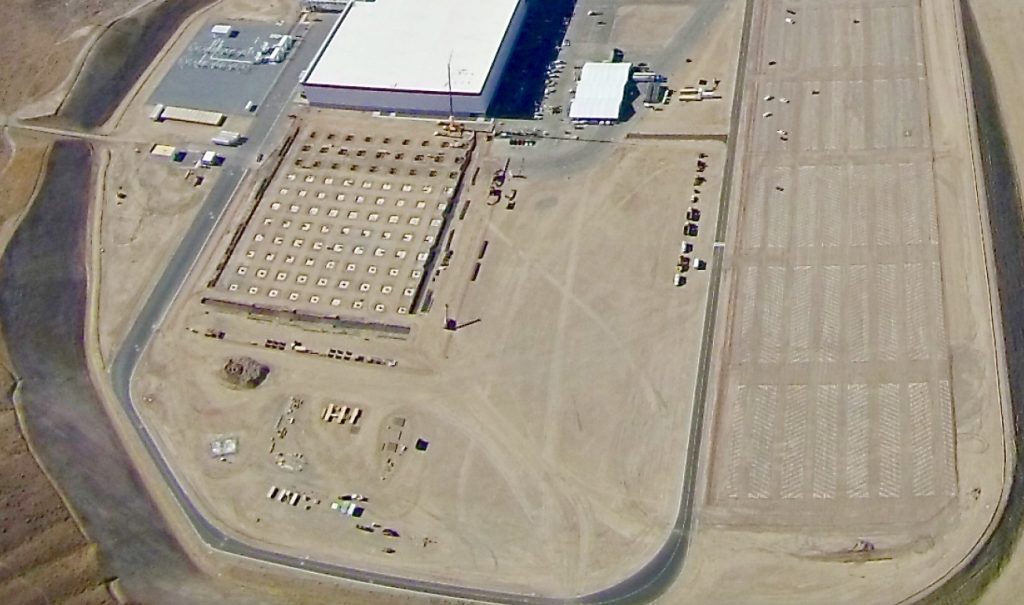
Test rides might be originating from near the white tent and on the paved road surrounding the outer perimeter of the Gigafactory 1 lot.
Musk’s vision for the future includes the use of Tesla’s battery plant as the supplier of li-ion cells for its upcoming fleet of Tesla trucks, semis and home and commercial energy solutions.
Tesla broke ground on its first Gigafactory in June 2014 and is expected to produce 105 gigawatt hours of battery cells when it reaches full production in 2020, and becomes the world’s largest producer and consumer of li-ion battery cells.
The four completed sections of the Gigafactory to date represents only 15% of the overall total size when completed. Josh Mcdonald of Nevada Tailwheel tells us, “Tesla has begun construction on the next phase of the Gigafactory as seen from the newly graded sections with concrete and steel pylons forming the base of the foundation directly to the north and south of the factory”.
We’ve outlined in red a few key areas of the Gigafactory seen from the aerial photo. Among the areas outlined are new sections north and south of the existing building, a helicopter landing zone and the security guard shack on Electric Avenue.

News
Tesla FSD fleet is nearing 7 billion total miles, including 2.5 billion city miles
As can be seen on Tesla’s official FSD webpage, vehicles equipped with the system have now navigated over 6.99 billion miles.

Tesla’s Full Self-Driving (Supervised) fleet is closing in on almost 7 billion total miles driven, as per data posted by the company on its official FSD webpage.
These figures hint at the massive scale of data fueling Tesla’s rapid FSD improvements, which have been quite notable as of late.
FSD mileage milestones
As can be seen on Tesla’s official FSD webpage, vehicles equipped with the system have now navigated over 6.99 billion miles. Tesla owner and avid FSD tester Whole Mars Catalog also shared a screenshot indicating that from the nearly 7 billion miles traveled by the FSD fleet, more than 2.5 billion miles were driven inside cities.
City miles are particularly valuable for complex urban scenarios like unprotected turns, pedestrian interactions, and traffic lights. This is also the difference-maker for FSD, as only complex solutions, such as Waymo’s self-driving taxis, operate similarly on inner-city streets. And even then, incidents such as the San Francisco blackouts have proven challenging for sensor-rich vehicles like Waymos.
Tesla’s data edge
Tesla has a number of advantages in the autonomous vehicle sector, one of which is the size of its fleet and the number of vehicles training FSD on real-world roads. Tesla’s nearly 7 billion FSD miles then allow the company to roll out updates that make its vehicles behave like they are being driven by experienced drivers, even if they are operating on their own.
So notable are Tesla’s improvements to FSD that NVIDIA Director of Robotics Jim Fan, after experiencing FSD v14, noted that the system is the first AI that passes what he described as a “Physical Turing Test.”
“Despite knowing exactly how robot learning works, I still find it magical watching the steering wheel turn by itself. First it feels surreal, next it becomes routine. Then, like the smartphone, taking it away actively hurts. This is how humanity gets rewired and glued to god-like technologies,” Fan wrote in a post on X.
News
Tesla starts showing how FSD will change lives in Europe
Local officials tested the system on narrow country roads and were impressed by FSD’s smooth, human-like driving, with some calling the service a game-changer for everyday life in areas that are far from urban centers.

Tesla has launched Europe’s first public shuttle service using Full Self-Driving (Supervised) in the rural Eifelkreis Bitburg-Prüm region of Germany, demonstrating how the technology can restore independence and mobility for people who struggle with limited transport options.
Local officials tested the system on narrow country roads and were impressed by FSD’s smooth, human-like driving, with some calling the service a game-changer for everyday life in areas that are far from urban centers.
Officials see real impact on rural residents
Arzfeld Mayor Johannes Kuhl and District Administrator Andreas Kruppert personally tested the Tesla shuttle service. This allowed them to see just how well FSD navigated winding lanes and rural roads confidently. Kruppert said, “Autonomous driving sounds like science fiction to many, but we simply see here that it works totally well in rural regions too.” Kuhl, for his part, also noted that FSD “feels like a very experienced driver.”
The pilot complements the area’s “Citizen Bus” program, which provides on-demand rides for elderly residents who can no longer drive themselves. Tesla Europe shared a video of a demonstration of the service, highlighting how FSD gives people their freedom back, even in places where public transport is not as prevalent.
What the Ministry for Economic Affairs and Transport says
Rhineland-Palatinate’s Minister Daniela Schmitt supported the project, praising the collaboration that made this “first of its kind in Europe” possible. As per the ministry, the rural rollout for the service shows FSD’s potential beyond major cities, and it delivers tangible benefits like grocery runs, doctor visits, and social connections for isolated residents.
“Reliable and flexible mobility is especially vital in rural areas. With the launch of a shuttle service using self-driving vehicles (FSD supervised) by Tesla in the Eifelkreis Bitburg-Prüm, an innovative pilot project is now getting underway that complements local community bus services. It is the first project of its kind in Europe.
“The result is a real gain for rural mobility: greater accessibility, more flexibility and tangible benefits for everyday life. A strong signal for innovation, cooperation and future-oriented mobility beyond urban centers,” the ministry wrote in a LinkedIn post.
News
Tesla China quietly posts Robotaxi-related job listing
Tesla China is currently seeking a Low Voltage Electrical Engineer to work on circuit board design for the company’s autonomous vehicles.

Tesla has posted a new job listing in Shanghai explicitly tied to its Robotaxi program, fueling speculation that the company is preparing to launch its dedicated autonomous ride-hailing service in China.
As noted in the listing, Tesla China is currently seeking a Low Voltage Electrical Engineer to work on circuit board design for the company’s autonomous vehicles.
Robotaxi-specific role
The listing, which was shared on social media platform X by industry watcher @tslaming, suggested that Tesla China is looking to fill the role urgently. The job listing itself specifically mentions that the person hired for the role will be working on the Low Voltage Hardware team, which would design the circuit boards that would serve as the nervous system of the Robotaxi.
Key tasks for the role, as indicated in the job listing, include collaboration with PCB layout, firmware, mechanical, program management, and validation teams, among other responsibilities. The role is based in Shanghai.
China Robotaxi launch
China represents a massive potential market for robotaxis, with its dense urban centers and supportive policies in select cities. Tesla has limited permission to roll out FSD in the country, though despite this, its vehicles have been hailed as among the best in the market when it comes to autonomous features. So far, at least, it appears that China supports Tesla’s FSD and Robotaxi rollout.
This was hinted at in November, when Tesla brought the Cybercab to the 8th China International Import Expo (CIIE) in Shanghai, marking the first time that the autonomous two-seater was brought to the Asia-Pacific region. The vehicle, despite not having a release date in China, received a significant amount of interest among the event’s attendees.
